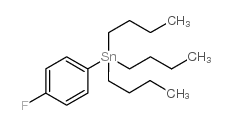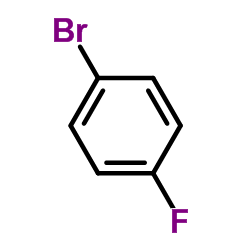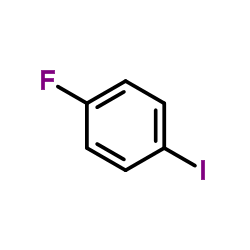tributyl-(4-fluorophenyl)stannane
Modify Date: 2025-08-25 10:55:48

tributyl-(4-fluorophenyl)stannane structure
|
Common Name | tributyl-(4-fluorophenyl)stannane | ||
|---|---|---|---|---|
| CAS Number | 17151-47-2 | Molecular Weight | 385.13800 | |
| Density | N/A | Boiling Point | 364.5ºC at 760mmHg | |
| Molecular Formula | C18H31FSn | Melting Point | N/A | |
| MSDS | N/A | Flash Point | 174.3ºC | |
| Name | tributyl-(4-fluorophenyl)stannane |
|---|---|
| Synonym | More Synonyms |
| Boiling Point | 364.5ºC at 760mmHg |
|---|---|
| Molecular Formula | C18H31FSn |
| Molecular Weight | 385.13800 |
| Flash Point | 174.3ºC |
| Exact Mass | 386.14300 |
| LogP | 5.88180 |
| Vapour Pressure | 3.51E-05mmHg at 25°C |
| InChIKey | FLPKMHDTSOPPOJ-UHFFFAOYSA-N |
| SMILES | CCCC[Sn](CCCC)(CCCC)c1ccc(F)cc1 |
Synonym:None Section 2 - COMPOSITION, INFORMATION ON INGREDIENTS
Risk Phrases: 21 25 36/38 48/23/25 50/53 Section 3 - HAZARDS IDENTIFICATION EMERGENCY OVERVIEW
Harmful in contact with skin. Toxic if swallowed. Irritating to eyes and skin. Toxic : danger of serious damage to health by prolonged exposure through inhalation and if swallowed. Very toxic to aquatic organisms, may cause long-term adverse effects in the aquatic environment. Potential Health Effects Eye: Causes eye irritation. Skin: Causes skin irritation. Harmful if absorbed through the skin. Ingestion: Harmful if swallowed. May cause irritation of the digestive tract. Inhalation: Harmful if inhaled. Causes respiratory tract irritation. Chronic: The critical effect of tributyltin compounds in rats is on the immune system (ACGIH 7th Edition Documentation of the TLVs). Exposure limits have been recommended for organotin compounds to minimize the potential for adverse effects on immune function and the CNS. Section 4 - FIRST AID MEASURES Eyes: Immediately flush eyes with plenty of water for at least 15 minutes, occasionally lifting the upper and lower eyelids. Get medical aid immediately. Skin: Get medical aid immediately. Immediately flush skin with plenty of water for at least 15 minutes while removing contaminated clothing and shoes. Ingestion: Get medical aid immediately. Wash mouth out with water. Inhalation: Get medical aid immediately. Remove from exposure and move to fresh air immediately. If not breathing, give artificial respiration. If breathing is difficult, give oxygen. Notes to Physician: Section 5 - FIRE FIGHTING MEASURES General Information: As in any fire, wear a self-contained breathing apparatus in pressure-demand, MSHA/NIOSH (approved or equivalent), and full protective gear. During a fire, irritating and highly toxic gases may be generated by thermal decomposition or combustion. Extinguishing Media: Use water spray, dry chemical, carbon dioxide, or chemical foam. Section 6 - ACCIDENTAL RELEASE MEASURES General Information: Use proper personal protective equipment as indicated in Section 8. Spills/Leaks: Absorb spill with inert material (e.g. vermiculite, sand or earth), then place in suitable container. Provide ventilation. Section 7 - HANDLING and STORAGE Handling: Wash thoroughly after handling. Remove contaminated clothing and wash before reuse. Use with adequate ventilation. Avoid contact with eyes, skin, and clothing. Avoid breathing vapor or mist. Storage: Store in a tightly closed container. Store in a cool, dry, well-ventilated area away from incompatible substances. Section 8 - EXPOSURE CONTROLS, PERSONAL PROTECTION Engineering Controls: Facilities storing or utilizing this material should be equipped with an eyewash facility and a safety shower. Use adequate general or local exhaust ventilation to keep airborne concentrations below the permissible exposure limits. Exposure Limits CAS# 17151-47-2: United Kingdom, WEL - TWA: (listed as tin organic compounds): 0.1 mg/m3 TWA (except cyhexatin, as Sn) United Kingdom, WEL - STEL: (listed as tin organic compounds): 0. mg/m3 STEL (except cyhexatin, as Sn) United States OSHA: 0.1 mg/m3 TWA (as Sn) (listed under Tin orga compounds). Belgium - TWA: (listed as tin organic compounds): 0.1 mg/m3 VLE ( Sn) Belgium - STEL: (listed as tin organic compounds): 0.2 mg/m3 VLE Sn) France - VME: (listed as tin organic compounds): 0.1 mg/m3 VME (a Sn) France - VLE: (listed as tin organic compounds): 0.2 mg/m3 VLE (a Sn) Germany: (listed as tin organic compounds): 0.1 mg/m3 VME (as Sn) Germany: (listed as tin organic compounds): Skin absorber Malaysia: (listed as tin organic compounds): 0.1 mg/m3 TWA (as Sn Netherlands: (listed as tin organic compounds): 0.2 mg/m3 STEL (a Sn) Netherlands: (listed as tin organic compounds): 0.1 mg/m3 MAC (as Spain: (listed as tin organic compounds): 0.1 mg/m3 VLA-ED (as Sn Spain: (listed as tin organic compounds): 0.2 mg/m3 VLA-EC (as Sn Personal Protective Equipment Eyes: Wear chemical splash goggles. Skin: Wear appropriate protective gloves to prevent skin exposure. Clothing: Wear appropriate protective clothing to prevent skin exposure. Respirators: Follow the OSHA respirator regulations found in 29 CFR 1910.134 or European Standard EN 149. Use a NIOSH/MSHA or European Standard EN 149 approved respirator if exposure limits are exceeded or if irritation or other symptoms are experienced. Section 9 - PHYSICAL AND CHEMICAL PROPERTIES Physical State: Viscous liquid Color: yellow Odor: Not available. pH: Not available. Vapor Pressure: Not available. Viscosity: Not available. Boiling Point: 132 - 134 deg C @0.1mmHg Freezing/Melting Point: Not available. Autoignition Temperature: Not available. Flash Point: Not available. Explosion Limits, lower: Not available. Explosion Limits, upper: Not available. Decomposition Temperature: Solubility in water: Specific Gravity/Density: Molecular Formula: C18H31FSn Molecular Weight: 385 Section 10 - STABILITY AND REACTIVITY Chemical Stability: Stable under normal temperatures and pressures. Conditions to Avoid: Excess heat, confined spaces. Incompatibilities with Other Materials: Strong oxidizing agents. Hazardous Decomposition Products: Carbon monoxide, carbon dioxide, tin/tin oxides, fluorine, hydrogen fluoride gas. Hazardous Polymerization: Has not been reported Section 11 - TOXICOLOGICAL INFORMATION RTECS#: CAS# 17151-47-2 unlisted. LD50/LC50: Not available. Carcinogenicity: Tributyl(4-fluorophenyl)stannane - Not listed by ACGIH, IARC, or NTP. Section 12 - ECOLOGICAL INFORMATION Other No information available. Section 13 - DISPOSAL CONSIDERATIONS Dispose of in a manner consistent with federal, state, and local regulations. Section 14 - TRANSPORT INFORMATION IATA Shipping Name: ORGANOTIN COMPOUND, LIQUID, N.O.S. Hazard Class: 6.1 UN Number: 2788 Packing Group: II IMO Shipping Name: ORGANOTIN COMPOUND, LIQUID, N.O.S. Hazard Class: 6.1 UN Number: 2788 Packing Group: II RID/ADR Shipping Name: ORGANOTIN COMPOUND, LIQUID, N.O.S. Hazard Class: 6.1 UN Number: 2788 Packing group: II Section 15 - REGULATORY INFORMATION European/International Regulations European Labeling in Accordance with EC Directives Hazard Symbols: T N Risk Phrases: R 21 Harmful in contact with skin. R 25 Toxic if swallowed. R 36/38 Irritating to eyes and skin. R 48/23/25 Toxic : danger of serious damage to health by prolonged exposure through inhalation and if swallowed. R 50/53 Very toxic to aquatic organisms, may cause long-term adverse effects in the aquatic environment. Safety Phrases: S 35 This material and its container must be disposed of in a safe way. S 36/37/39 Wear suitable protective clothing, gloves and eye/face protection. S 45 In case of accident or if you feel unwell, seek medical advice immediately (show the label where possible). S 60 This material and its container must be disposed of as hazardous waste. S 61 Avoid release to the environment. Refer to special instructions/safety data sheets. WGK (Water Danger/Protection) CAS# 17151-47-2: No information available. Canada None of the chemicals in this product are listed on the DSL/NDSL list. CAS# 17151-47-2 is not listed on Canada's Ingredient Disclosure List. US FEDERAL TSCA CAS# 17151-47-2 is not listed on the TSCA inventory. It is for research and development use only. SECTION 16 - ADDITIONAL INFORMATION N/A |
| Hazard Codes | T: Toxic; |
|---|---|
| Risk Phrases | R21;R25;R36/38;R48/23/25;R50/53 |
| Safety Phrases | S35-S36/37/39-S45-S60-S61 |
| RIDADR | UN 3146 |
|
~98% 
tributyl-(4-flu... CAS#:17151-47-2 |
| Literature: PRESIDENT AND FELLOWS OF HARVARD COLLEGE; RITTER, Tobias; FURUYA, Takeru; TANG, Pingping Patent: WO2010/59943 A2, 2010 ; Location in patent: Page/Page column 33 ; |
|
~78% 
tributyl-(4-flu... CAS#:17151-47-2 |
| Literature: Gmelin Handbook: Sn: Org.Verb.2, 1.1.2.5.6, page 318 - 322 |
| tributyl(4-fluorophenyl)stannane |
| 4-Fluoro-(tributylstannyl)benzene |
| 4-fluorophenyltributyltin |
| p-FC6H4SnBu3 |
| 4-Fluoro-(tri-n-butylstannyl)benzene |
| (4-Fluorophenyl)tributylstannane |
| 4-fluorophenyl-tri-n-butylstannane |


